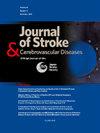Factors associated with increased atrial fibrillation detection in patients with embolic stroke of undetermined source
IF 2
4区 医学
Q3 NEUROSCIENCES
Journal of Stroke & Cerebrovascular Diseases
Pub Date : 2025-05-07
DOI:10.1016/j.jstrokecerebrovasdis.2025.108343
引用次数: 0
Abstract
Background
Studies suggest that longer duration of cardiac monitoring after embolic stroke of undetermined source (ESUS) yields higher detection rates for atrial fibrillation (AF). A common strategy for cardiac monitoring after ESUS starts with a 14-day surface monitor, which is easier to administer, and lower cost compared to implantable monitoring. We tested whether cardiac markers associated with higher likelihood of AF detection can be used to identify patients with ESUS who are more likely to benefit from initial short-term monitoring.
Methods
We adjudicated stroke etiology from patients with acute ischemic stroke discharged from a tertiary care medical center with 14-day surface cardiac monitor (ZioPatch®) between January 2019 and September 2023. The primary outcome was ≥30 seconds of AF on surface monitoring. Predictors included ECG and echocardiographic markers associated with AF in a general population identified during hospitalization. Associations were analyzed using Chi-squared or Fisher’s exact tests and age-adjusted logistic regression.
Results
We identified 415 patients with ESUS (mean age 67.2 years, 49.9% female). 4.3% (n=18/415) developed AF after a median of 13.8 days (IQR 13-15.8) of monitoring. 9.6% (n=8/83) of patients with enlarged left atrial dimension >4cm and 8.0% (n=9/113) of patients with mitral valve regurgitation developed AF. Significantly more patients with AF had a combination of enlarged left atrial dimension and/or mitral valve regurgitation (36.8% with AF vs 61.1% without AF, p=0.037). Adjusting for age, enlarged left atrial dimension remained significantly associated with increased odds of detection of AF (OR 3.17, 95% CI 1.20-8.36).
Conclusions
In patients with ESUS, the rate of AF detection using a surface 14-day cardiac monitor was low. However, the likelihood of detecting AF was higher among patients with enlarged left atrial dimension and mitral valve regurgitation, suggesting this group may benefit most from an initial short-term monitoring strategy.
来源不明的栓塞性卒中患者心房颤动检出率增高的相关因素
研究表明,来源不明的栓塞性卒中(ESUS)后心脏监测时间越长,心房颤动(AF)的检出率越高。ESUS后心脏监测的常用策略是从14天的表面监护开始,与植入式监护相比,这种监护更容易管理,成本更低。我们测试了与AF检测可能性较高相关的心脏标志物是否可用于识别ESUS患者,这些患者更有可能从最初的短期监测中获益。方法对2019年1月至2023年9月期间从三级医疗中心出院的急性缺血性脑卒中患者进行14天表面心脏监护(ZioPatch®)诊断卒中病因。主要终点为体表监测AF≥30秒。预测因素包括住院期间确定的普通人群中与房颤相关的心电图和超声心动图标记。使用卡方检验或Fisher精确检验和年龄调整逻辑回归分析相关性。结果415例ESUS患者(平均年龄67.2岁,女性49.9%)。4.3% (n=18/415)在中位监测13.8天(IQR 13-15.8)后发生房颤。9.6% (n=8/83)左房面积增大4cm的患者发生房颤,8.0% (n=9/113)二尖瓣返流的患者发生房颤。更多的房颤患者合并左房面积增大和/或二尖瓣返流(房颤组36.8% vs无房颤组61.1%,p=0.037)。调整年龄后,左房面积增大仍与房颤的检测几率增加显著相关(OR 3.17, 95% CI 1.20-8.36)。结论在ESUS患者中,表面14天心电监护的AF检出率较低。然而,发现房颤的可能性在左心房尺寸增大和二尖瓣反流的患者中更高,这表明这组患者可能从最初的短期监测策略中获益最多。
本文章由计算机程序翻译,如有差异,请以英文原文为准。
求助全文
约1分钟内获得全文
求助全文
来源期刊

Journal of Stroke & Cerebrovascular Diseases
Medicine-Surgery
CiteScore
5.00
自引率
4.00%
发文量
583
审稿时长
62 days
期刊介绍:
The Journal of Stroke & Cerebrovascular Diseases publishes original papers on basic and clinical science related to the fields of stroke and cerebrovascular diseases. The Journal also features review articles, controversies, methods and technical notes, selected case reports and other original articles of special nature. Its editorial mission is to focus on prevention and repair of cerebrovascular disease. Clinical papers emphasize medical and surgical aspects of stroke, clinical trials and design, epidemiology, stroke care delivery systems and outcomes, imaging sciences and rehabilitation of stroke. The Journal will be of special interest to specialists involved in caring for patients with cerebrovascular disease, including neurologists, neurosurgeons and cardiologists.
 求助内容:
求助内容: 应助结果提醒方式:
应助结果提醒方式:


